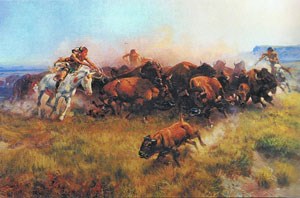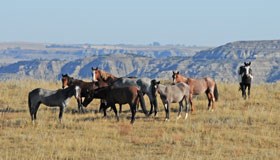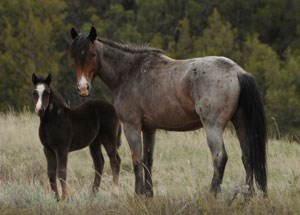|
This page has not been updated during the planning process. This web page and others would be updated in the future, as appropriate. The FAQs provide the most recent and updated guidance regarding horses and cattle. Origins of the Horse in North AmericaThe modern horse (Equus caballus) evolved on the North American continent. Disappearing from this area around 10,000 years ago (end of the Pleistocene epoch), it survived on the European/Asian continent. Horses were brought back to North America by the Spanish in the 1500s. 
© Charles M. Russel Horses on the Great PlainsReintroduction of horses changed the social and environmental landscape of the Great Plains, most notably for the Plains Indians. Their acquisition of the horse changed their culture from pedestrian hunter-gatherers to mounted buffalo hunters and warriors. Horses played a significant role in the exploration and settlement of the United States. 
NPS / Chad Allmendinger Horses in Theodore Roosevelt National ParkTheodore Roosevelt National Park is one of the few national parks where visitors can observe free-roaming horses. Their presence represents Theodore Roosevelt’s experiences here during the open-range ranching era. By the late 1800s European settlement of the plains had reached the Dakotas. Ranchers turned horses out on the open range to live and breed. When needed, they would round up horses and their offspring for use as ranch horses. For generations, ranchers used land that would later become the park for open-range grazing. Horse BehaviorDuring the summer months, bands of horses may be seen grazing throughout the park. They are often seen along the park boundary from Interstate 94. Horses can also be seen at a distance from high points such as the Painted Canyon Overlook and Buck Hill. While hiking or driving, look for fresh manure to locate horses –stallions mark their territory with "stud piles." These are common along the scenic drive through the park. Feral horses typically range in small bands of 5-15 animals. Each group has an established social hierarchy, consisting of a dominant stallion, his mares, and their offspring. Frequently a subdominant stallion will "run second" to the leader. Stallions herd their mares by extending their heads and necks low to the ground in a gesture known as "snaking." When a band is in flight, a dominant mare will take the lead with the stallion bringing up the rear. Young stallions roam together in bachelor groups, sometimes in proximity to a stallion harem. 
NPS / Chad Allmendinger Once formed, these social groups remain remarkably stable and often range within an established territory. Foals are born in the spring after an 11 month gestation period. Upon reaching sexual maturity at age 2-3, young colts and fillies are driven from their natal group and form new bands. Occasionally a bachelor stallion attempts to steal mares from an established group, resulting in fights between rival males. Extreme caution must be exercised in attempting to observe feral horses closely. Binoculars are advised for optimal viewing. Horses have keen senses of smell, hearing, and sight. They are extremely wary, often sensing the presence of humans in advance. They are especially fearful of horseback riders. Please do not feed, chase, harass or otherwise approach horses. Free-roaming horses should be treated with respect and caution. If you are interested in helping the park's horses, please keep an eye out for more details coming soon about the horse adoption program sponsored by our partner, General Services Administation (GSA). |
Last updated: July 2, 2025
